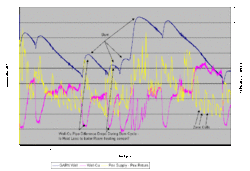Good Morning,
I finally got my one-wire temp sensor network up and running. Currently my network is about 175' with 5 sensors and I am monitoring my My GARN Water Temp, and the house circuit supply and return in the GARN Barn. I also have 2 extra sensors I set up for debug. I'm using the Dallas DS18B20 sensors. My questions are to those of you who have been through the "one wire sensor" data logger projects, or anyone with thoughts on accurate temperature measurement.
I have the standard dial thermometer in a well on the face of our GARN. I also installed a thermowell next to that thermometer for my one-wire sensor. I have a consistent offset between the thermometer and well sensor of about 6°F (the onewire sensor reads 6 °F lower). I then have senors on my supply and return pex. Those sensors are on the pex pipe, under 2" fiberglass pipe insulation, with no thermal grease, simply wrap tied to the pipes. My supply sensor consistently reads a 16 °F Offset from the Thermometer. The return of course varies it's value, and I have no reference to compare. I placed my debug sensor on a copper supply pipe, and found I could decrease the offset relative to the thermometer by about 4 °F .
So, my Questions:
1) Has anyone experienced this type of calibration issue, and what have you done to solve you problem?
2)Should I just accept the 6 °F well to thermometer offset, the 12 °F pipe to thermometer offset, and then just calibrate it out of my measurements, and be done with it?
3)What is the best way to attach one-wire sensors to copper and pex pipes?
My guess, this might be a re-hash for some, but new for me. Any help would be greatly appreciated.
I finally got my one-wire temp sensor network up and running. Currently my network is about 175' with 5 sensors and I am monitoring my My GARN Water Temp, and the house circuit supply and return in the GARN Barn. I also have 2 extra sensors I set up for debug. I'm using the Dallas DS18B20 sensors. My questions are to those of you who have been through the "one wire sensor" data logger projects, or anyone with thoughts on accurate temperature measurement.
I have the standard dial thermometer in a well on the face of our GARN. I also installed a thermowell next to that thermometer for my one-wire sensor. I have a consistent offset between the thermometer and well sensor of about 6°F (the onewire sensor reads 6 °F lower). I then have senors on my supply and return pex. Those sensors are on the pex pipe, under 2" fiberglass pipe insulation, with no thermal grease, simply wrap tied to the pipes. My supply sensor consistently reads a 16 °F Offset from the Thermometer. The return of course varies it's value, and I have no reference to compare. I placed my debug sensor on a copper supply pipe, and found I could decrease the offset relative to the thermometer by about 4 °F .
So, my Questions:
1) Has anyone experienced this type of calibration issue, and what have you done to solve you problem?
2)Should I just accept the 6 °F well to thermometer offset, the 12 °F pipe to thermometer offset, and then just calibrate it out of my measurements, and be done with it?
3)What is the best way to attach one-wire sensors to copper and pex pipes?
My guess, this might be a re-hash for some, but new for me. Any help would be greatly appreciated.



